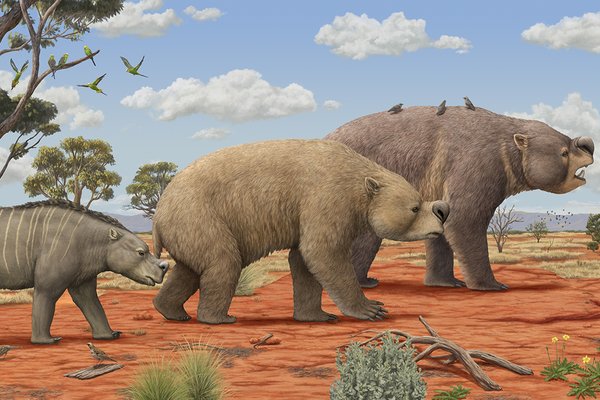In-tree-guing new marsupials discovered!

The Tree Kangaroo, Dendrolagus Lumholtzi, Collett
Image: -© Reproduction Rights Australian Museum
The first comprehensive genetic study of tree-kangaroos has revealed the presence of at least three additional species hiding in the forests of New Guinea despite hiding in plain sight in museum collections for over 100 years.
The concept of a tree-living (arboreal) kangaroo, sounds like the product of an over-active imagination. Yet within the kangaroo and wallaby family (Macropodidae) one anomalous group, the tree-kangaroos genus Dendrolagus, has indeed abandoned the terrestrial lifestyle of their kin to return to life in the trees. Modern tree-kangaroos are confined to the wet tropical forests of north Queensland, Australia (2 species) and New Guinea (8 species). Although scientifically intriguing and aesthetically attractive, they are amongst the most poorly known large mammals in Australasia.
Due to their inaccessible distributions, elusive behaviour and dense forested habitat our understanding of tree-kangaroo taxonomy and evolutionary history was limited and controversial. Some species are only known from a handful of specimens and for over eight decades scientists had been revising and re-revising tree-kangaroo relationships based on morphological features such as coloration, hair-whorls, skull and teeth structure and foot length, with these studies often coming to very different conclusions. However, the tree-kangaroo specimens held in museums in Australia and abroad, some for over 100 years, provided a unique opportunity to add genetic analyses to the previous morphological studies and break the impasse.
To improve our understanding of relationships within this group we utilised the Australian Museum’s unparalleled collection of tree-kangaroos to obtained samples from all currently recognised tree-kangaroo species, including representatives from 14 of the 17 currently recognised or proposed subspecies and generated DNA sequence data from eight genes. Phylogenetic analysis of these data, resolved many long-standing issues in tree-kangaroo systematics, revealing six major genetic groups within tree-kangaroos - one in Australia and five highly divergent groups in New Guinea. Although tree-kangaroos appear to have originated in Australia, they reached New Guinea not long after the landmass formed and have diversified spectacularly. They now inhabit a range of wet forest types in New Guinea from sea level, to over 4000m!
Within tree-kangaroos, there is evidence of a shift in tail length and foot shape associated with increased tree-climbing ability. Tree-kangaroos also have larger and stronger forearms compared to other kangaroos/wallabies to support their arboreal lifestyles. However, in a strange evolutionary twist one species of tree-kangaroo, the Dingiso (D. mbaiso) from the high elevation (3000-4000m) sub-alpine scrub of West Papua, has again become largely terrestrial. So, just what do you call the biological oxymoron that is a terrestrial tree-kangaroo…?
We also found unexpectedly high levels of genetic divergence within several currently recognised New Guinea tree-kangaroo species. These major genetic differences largely correspond to the morphologically distinct subspecies currently recognised within Goodfellow’s tree-kangaroo (D. goodfellowi) and Doria’s tree-kangaroo (D. dorianus). We have therefore concluded that at least three of these subspecies would more accurately be regarded as full species. These are the Golden-mantled Tree-kangaroo (D. pulcherrimus) from the northern coastal ranges, as well as the Ifola (D. notatus), and Seri’s Tree-kangaroo (D. stellarum) from the Central Ranges. All these newly recognised species are listed as threatened by the IUCN as a result of increasing loss of forest habitat and hunting pressure. Clarifying their taxonomic status will aid conservation efforts by ensuring that populations are correctly identified and managed at the most appropriate geographic scale. Several additional genetically distinct groups are still under investigation and additional species may yet be uncovered. This study again highlights the incredible, but poorly documented, biodiversity of New Guinea (Australia’s nearest neighbour), and underlines our rich and intertwined biological history.
Dr Mark Eldridge, Principal Research Scientist, Terrestrial Vertebrates, Australian Museum Research Institute
Dr Sally Potter, Research Associate, Australian Museum Research Institute. Postdoctoral Fellow, Australian National University
Dr Rebecca Johnson, Director, Australian Museum Research Institute
More information:
- Eldridge, M.D.B., Potter, S., Helgen, K.M., Sinaga, M.H., Aplin, K.P., Flannery, T.F. and Johnson, R.N. 2018. Phylogenetic analysis of the tree-kangaroos (Dendrolagus) reveals multiple divergent lineages within New Guinea. Molecular Phylogenetics and Evolution, on line.












